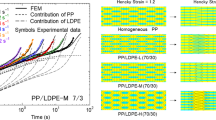Abstract
Due to the interfacial tension, immiscible blends can show an elastic recovery that is substantially larger than that of their pure components. Here it is attempted to relate the elastic recovery after steady shear flow to the underlying morphology. On the one hand, the predictions of the Palierne and the Doi-Ohta models are calculated for the flow conditions during recoil. On the other hand, systematic recoil experiments after steady state shearing have been performed on a model blend. As the component polymers hardly show any recoil under the stresses applied in these tests, the measured recovery can be attributed completely to the action of the interface. Comparison of the model predictions with the experimental results shows that the recoverable strain can be derived quantitatively from the linear Palierne theory. Although the droplet deformation remained limited during the preshear, the retardation time predicted by this model has to be multiplied by the aspect ratio of the droplet phase to the power 2/3 to describe the experiments. For conditions in which the material does not show an intrinsic length scale, particular scaling relations as derived from the Doi-Ohta theory are found to apply also to recoil.
Similar content being viewed by others
Author information
Authors and Affiliations
Additional information
Received: 5 August 1998 Accepted: 17 November 1998
Rights and permissions
About this article
Cite this article
Vinckier, I., Moldenaers, P. & Mewis, J. Elastic recovery of immiscible blends 1. Analysis after steady state shear flow. Rheol. Acta 38, 65–72 (1999). https://doi.org/10.1007/s003970050156
Issue Date:
DOI: https://doi.org/10.1007/s003970050156




